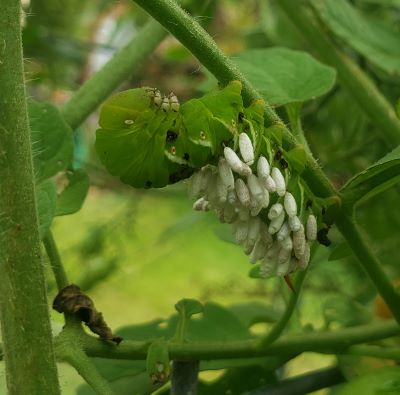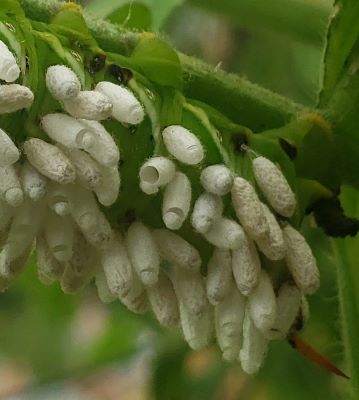Despite our small yard, the wonders of nature often pop up unexpectedly. While harvesting some tomatoes from our garden, my eye spied something white among the green leaves. On closer examination, I recognized a hornworm caterpillar covered with white beads.

At first, I assumed I had a Tomato Hornworm (Manduca quinquemaculata); after all it sat on my tomato plants. Checking more closely, I could see we actually hosted a Tobacco Hornworm (Manduca sexta). These two very similar looking species can be identified by the color of the horn– orange for Tobacco Hornworm.
The adult, a fairly large nocturnal moth, has the name of Carolina Sphynx Moth. Both species of hornworms can be pests to garden plants like tomatoes. They grow about as large as and fatter than one’s little finger, feeding voraciously. Many websites say, to protect your plants, pick them off and kill them–not my style. If I had found it earlier, I would still have let it feed as we had many tomato plants this year.
Those fat white grains of rice sticking out of the worms back provide the exciting part of this discovery. What’s going on?
Early in the season, a female Braconid Wasp, most likely Cotesia congregata, follow the aromas emitted by a plant under attach and by the caterpillar to find her prey. At about 1/16 inch, most of us would never notice her. Once she finds a host, she lays eggs, lots of eggs, usually about 65, just under the skin of the victim. The sting that lays each egg includes a venom and a virus which prevents the caterpillar’s immune system from attacking and killing the egg or larva. This cocktail also slows down the development of the caterpillar preventing it from maturing before the wasp larva pupate and leave.
Within a couple days, the egg hatches and the larva crawls into the caterpillar and starts feeding on the insect’s hemolymph (essentially its blood). After about 12 to 16 days, the larva has grown large enough. It chews its way out and emerges from the skin of the caterpillar.
The larva creates the silken cocoon where it pupates and eventually emerges as an adult. If it is late in the season, the larva will spin their cocoon which will fall to the ground where the larva spends the winter before pupating and emerging as an adult. If one looks closely at the image of the caterpillar you will see that most, if not all, of the pupal cocoons have opened and released adults to find new prey.

References
Species Manduca sexta – Carolina Sphinx – Hodges#7775 – BugGuide.Net

Comments
3 responses to “Life and Death in our Yard”
A great bit of nature interpretive work Bob, reminds me of my early naturalist days.
Thanks so much for publishing this. Brought back memories of finding tomato hornworms in my grandparents garden (maybe tobacco too, who knows?) Some of them had those cocoons on them, too. And now the mystery of what they were has been revealed!
Also, as a kid I had little compunction about squishing those big fat caterpillars— not so sure I could do it now 😌
Hope all is well for you and Eileen— all the best to you both
I found a Tomato Horn Worm in my garden and it was covered with these cocoons. I let nature do its thing.